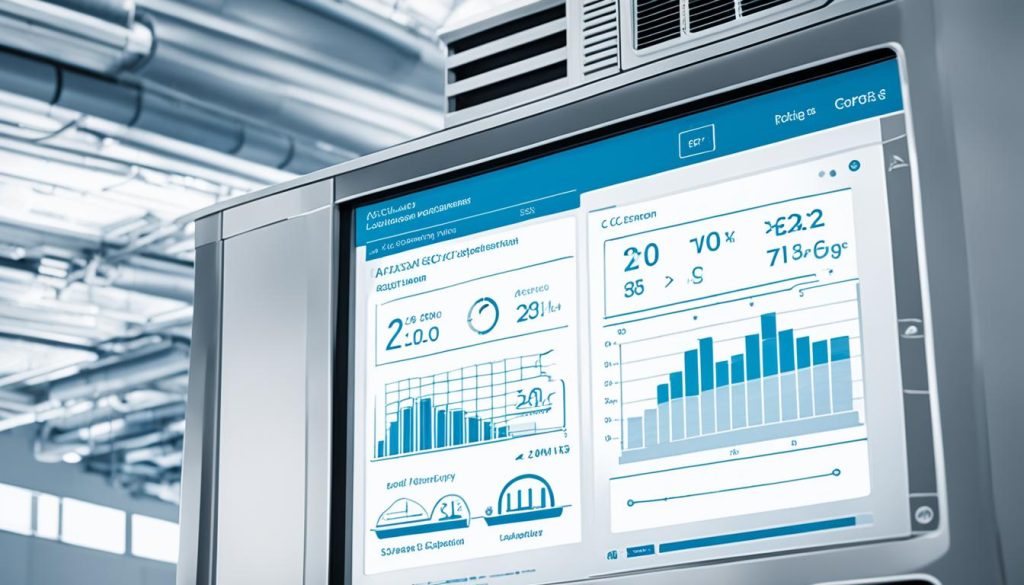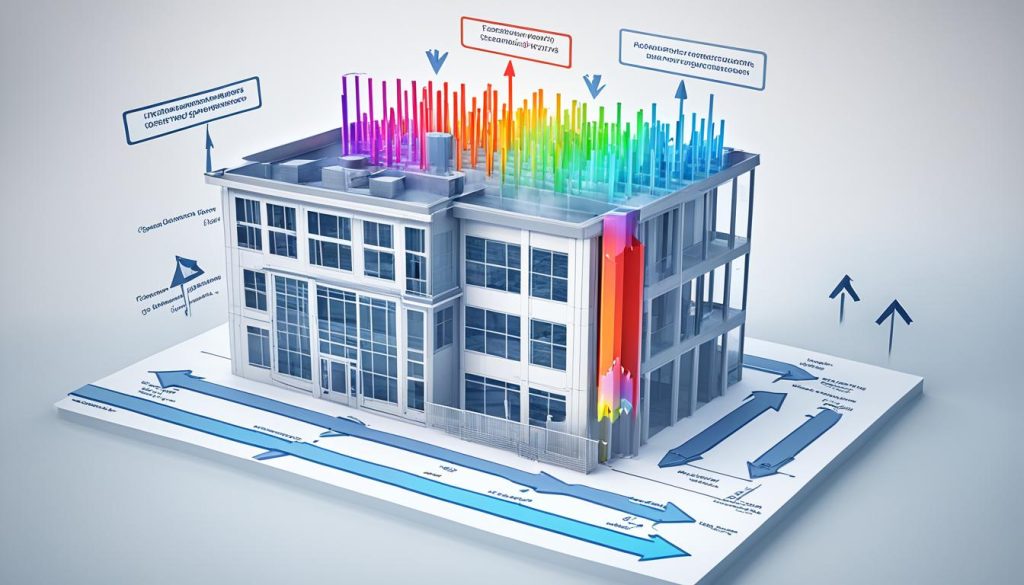Knowing the best HVAC load calculation software is key for professionals in heating, ventilation, and air conditioning. These tools help with accurate heating and cooling load counts. They lead to energy efficiency and installations that follow the rules.
It’s important to use ACCA-approved software for right results. They follow set rules like Manual J®, Manual D®, and Manual N® for exact residential load numbers. Some software doesn’t stick to these rules. So, choosing from Wrightsoft Right-J8, Elite RHVAC, and Adtek Acculoads is a good idea for precise outcomes.
Key Takeaways
- HVAC load calculation software is essential for accurate heating and cooling load assessments.
- Using ACCA-approved tools ensures compliance with industry standards.
- Top software options include Wrightsoft Right-J8, Elite RHVAC, and Adtek Acculoads.
- Compliance with Manual J®, Manual D®, and Manual N® is critical for code adherence.
- For commercial applications, robust solutions like IES’s APACHE engine and IESVE suite are recommended.
- Choosing the right software enhances energy efficiency and overall system performance.
Understanding HVAC Load Calculations
Getting HVAC load calculations right is key for a good heating, ventilation, and air conditioning system. It’s all about picking the right size and type of HVAC to keep a space comfy and energy efficient.
Importance of Load Calculations
Figuring out proper HVAC load is very important. It makes sure your HVAC can handle the heating and cooling needs of the building. If you get it wrong, the system might use too much energy or not work well. This affects how cozy people feel and how long the system lasts.
Types of Load Calculations: Heating and Cooling
There are different types of HVAC load, like for heating and cooling. They look at things like weather, building size, materials, and even how much heat people inside make. Heating load checks how much warmth is needed in winter. Cooling load finds out the cooling needed in summer. These steps are crucial when designing an HVAC to work well all year.
Impact on Energy Efficiency
Getting load calculations right also boosts how efficient your HVAC system is. Accurate calculations help the whole system work its best. A system that’s too small might overwork. One that’s too big could use more energy and not control humidity well. Good calculations lead to savings, lower costs, and a better running system. Starting off with exact load work is how you do energy-smart HVAC designs.
What is HVAC Load Calculation Software?
HVAC load calculation software is key for finding the right heating and cooling needs for spaces. It makes this process accurate and easier, meeting set standards. This boosts HVAC system efficiency.

Key Features to Look For
Choosing the right HVAC load calculation software requires checking several important features. Look for software that meets ACCA’s Manual J. It must be easy to use and provide correct data. The ability to work with other design tools is important too. And it should be useful for homes and businesses alike.
Difference Between Manual and Automated Calculations
There’s a big difference between doing manual HVAC calculations and using automated HVAC calculations. Manual work takes a lot of time and care, which can lead to mistakes. On the other hand, using software means faster, more accurate results. This cuts down on errors. A good HVAC software guide is a major help for professionals and businesses. It ensures accuracy and saves a lot of time.
Benefits of Using HVAC Load Calculation Software
Using HVAC load calculation software has many benefits. It makes sure the system’s needs are right. It cuts the chance of making mistakes, keeping the AC or heating working well.
It also saves you time. The software does hard math for you. This lets you spend time on other important parts of the job. It makes projects finish on time more often.
Following the rules is easier too. The software meets standards like ACCA’s Manual J, D, and N. This means your plans are more likely to be right the first time. It avoids hiccups because of rule breaking.
Getting the system size right helps save money. A system that fits well uses just the right amount of power. This means it works well without wasting energy. So, your project becomes more efficient.
Here are some specific benefits of using HVAC load calculation software:
- Accuracy: Reduces human error in calculations, improving system performance.
- Time Savings: Automates complex calculations, speeding up the design process.
- Compliance: Ensures adherence to building codes and standards.
- System Efficiency: Helps in optimizing the HVAC system for better performance and cost savings.
Overall, HVAC load calculation software is key for professionals. It boosts accuracy, speeds up work, keeps you compliant, and makes projects more efficient. It’s a must-have tool for anyone in the HVAC field.
| Benefit | Description |
|---|---|
| Accuracy | Improves system performance by reducing human error. |
| Time Savings | Automates complex calculations, speeding up the design process. |
| Compliance | Ensures adherence to building codes and standards. |
| System Efficiency | Optimizes the HVAC system for better performance and cost savings. |
ACCA-approved HVAC Load Calculation Software
Using ACCA-approved HVAC software is super important. It makes sure our math is right when we design systems. This is key for making sure everything works well.
Why ACCA Approval Matters
When ACCA approves a tool, it means it meets the best standards. So, designs made with this are both good and follow the law. Tools like Manual J, D, and N are a big part of this.
With ACCA tools, professionals worry less. They know their work will follow the rules. This means fewer mistakes and better-designed systems.
Top ACCA-approved Software Options
There are many great options with ACCA’s seal of approval. Wrightsoft Right-J8 and Elite RHVAC are two good examples. They use Manual J, D, and N to do the job right.
For anyone in HVAC, these are must-have tools. They ensure your designs are top-notch and meet every rule. This is vital for both quality work and happy clients.

Compliance with Building Codes
Sticking to the building codes is crucial in HVAC work. ACCA software makes it easier to follow these rules. Bad designs might need fixing later and even cause danger.
Using ACCA tools means you know your design is correct. It keeps you and your clients worry-free. Doing things the right way is always the best choice.
Residential HVAC Load Calculation Software
It’s crucial to pick the right software for residential HVAC load calculation. This choice impacts energy efficiency and comfort in homes and small areas. The software is made just for homes. It makes system design easier.

Features Specific to Residential Needs
This kind of software has special features for smaller homes and structures. It offers interfaces that are easy to understand, detailed reports, and customization options. This lets you do accurate calculations for each place. Some key features are:
- User-friendly design for seamless operation and understanding
- Detailed reporting to help homeowners comprehend energy efficiency
- Customizable options to meet specific dwelling requirements
- Support for ACCA Manual J compliance, ensuring code requirements are met
Popular Choices for Residential Applications
Choosing the right software means looking at reliability, accuracy, and support. Professionals prefer:
| Software | Notable Features |
|---|---|
| Wrightsoft Right-J8 | Comprehensive load calculations, ACCA-certified, user-friendly |
| Elite RHVAC | Accurate load calculations, extensive reporting, compliance with Manual J |
| Adtek Acculoads | Room-by-room and zone-by-zone calculations, easy-to-navigate interface |
These software options have great residential HVAC features. They help professionals offer top-notch services. Using them improves project success. It also ensures HVAC systems are energy-efficient and meet the codes.
Commercial HVAC Load Calculation Software
Dealing with the needs of big commercial buildings requires special commercial HVAC load calculation software. These tools are designed to meet specific demands of large structures. They connect with building management systems. This makes the heating, ventilation, and air conditioning work smoothly together.

Handling Complex Commercial Requirements
Things are very different in commercial buildings than homes. That’s why we need top-notch HVAC system design tools. They have to handle things like changing how many people are there, the many ways the space is used, and large areas. They make sure the heating and cooling keeps up with the needs of everyone inside.
Integration with Building Management Systems
The best part about modern commercial HVAC load calculation software is it can work with building management systems. This lets people track and adjust things in real time. It helps save energy and makes the system work better. By linking HVAC with other systems, managers can run the building more effectively and greenly.
Let’s look at some top commercial HVAC load calculation tools for a clearer picture:
| Software | Key Feature | Integration Capability | Target Application |
|---|---|---|---|
| Trane TRACE® 700 | Detailed Simulation Models | Full BMS Integration | Large Commercial Buildings |
| Carrier HAP | Energy Analysis | Partial BMS Integration | Medium to Large Buildings |
| Daikin VRV | Variable Refrigerant Flow | Complete BMS Integration | Complex Zoning Projects |
Picking the correct commercial HVAC load calculation software is key for big projects. With advanced HVAC design tools that merge well with building management systems, you can boost your building’s performance. This keeps the indoor spaces at their best and most efficient.
Accurate HVAC Load Calculations: Best Practices
Getting HVAC load calculations right is key. This makes sure systems work well. Use the latest climate data and put in building details right. This way, you cover all heat and cold sources well.
Keep your software updated. This matches it with new building codes. Your work will be reliable. Also, pick climate data carefully to capture weather changes’ impact on calculations.

- Utilize current and accurate climate data specific to your project location.
- Ensure all building details, such as materials and dimensions, are correctly entered into the software.
- Account for internal heat sources, including occupants, equipment, and lighting.
- Regularly update your software to incorporate the latest standards and building codes.
Adhering to these HVAC best practices boosts your work’s dependability. Keep learning and following standards. This ensures you meet needs in both performance and following the rules.
| Best Practices | Impact |
|---|---|
| Use up-to-date climate data | Improves accuracy by considering current weather variations |
| Accurate building details entry | Ensures calculations reflect real-world conditions |
| Consider internal heat sources | Fine-tunes the system to manage all heat gains and losses |
| Regular software updates | Keeps your calculations aligned with the latest codes and standards |
Using these strategies makes HVAC pros’ load calculations precise and thorough. This doesn’t only better system results but also earns trust from clients looking for top HVAC answers.
Top HVAC Load Calculation Software Tools
Finding the best HVAC software for load calculations is key. Look at features, industry nods, user feedback, and how it works overall. Tools like Wrightsoft Right-J8, Elite RHVAC, and Adtek Acculoads are top choices. They shine for their detailed reports, preciseness, easy use, and strong support.
Wrightsoft Right-J8 excels in making accurate Manual J load calculations. It stands out for checking all boxes set by the ACCA. This tool does Room-by-Room calculations. This means it customizes HVAC solutions for every room. Meanwhile, Elite RHVAC wins hearts for its simple design and detailed analysis. It covers both home and business needs, showing its flexibility.
Adtek Acculoads catches the eye with its Block Load and Zone-by-Zone calculations. It fits simple or complicated HVAC requirements. Known for its trustworthiness, it sticks to high standards. For big projects, tools like IES’s APACHE and IESVE offer thorough looks. They work with ASHRAE design rules and link well with current building systems.
Selecting the right software means you need to compare carefully based on what you need. The best choices mix tech progress with what’s hot in the industry. This keeps them sharp and useful for HVAC experts. It’s all about focusing on features, reliability, and being up-to-date in the field. This is how you pick the top HVAC software for load calculations and improve your system designs.





0 Comments